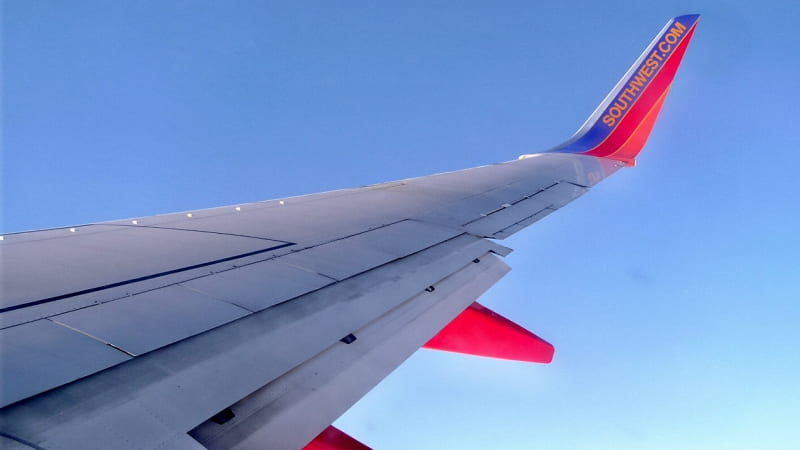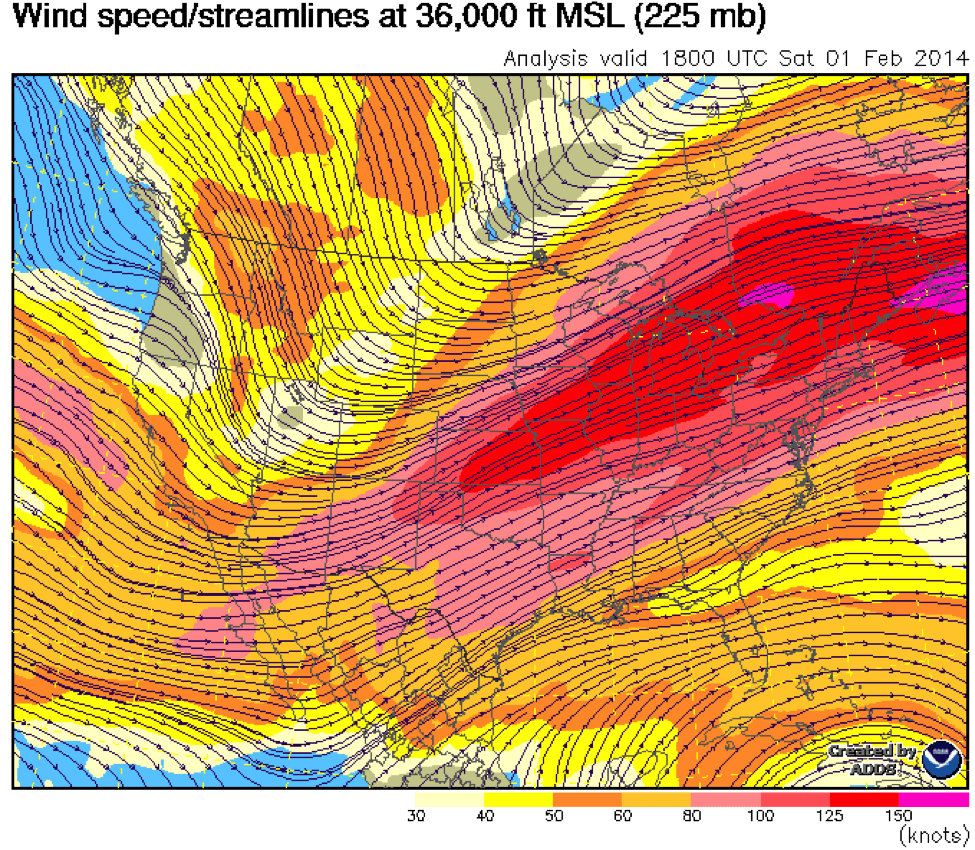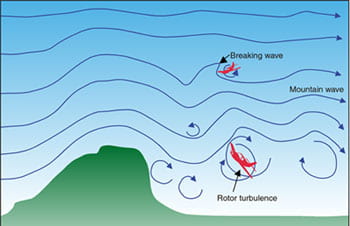THE TRUTH ABOUT TURBULENCE
By: Ethan Coffel

Image courtesy of Obilvion8000/WIKIMEDIA COMMONS
Most flights have at least a few minutes of bumpiness (in my experience, always as the food is served). Some of us think it’s interesting and perhaps fun – but most flyers, of course, do not. Either way, it’s nothing to get excited about. So, what exactly causes turbulence and how bad can it get?
Aloft, just like at the surface, there is wind. And, the winds are much stronger a few miles up than they are down on the ground. Figure 1 shows the wind speed and direction at 36,000 feet, a typical cruising altitude. The red areas indicate winds over 125 knots, or about 144 miles per hour – tornado-like winds! But they’re not really tornado-like at all. Airplanes routinely fly through winds in excess of 150 or 200 miles per hour with no trouble because, while the winds aloft are fast, they are also for the most part steady. Just like a small boat can smoothly glide down a fast-moving river, an airplane can cruise right along inside of a powerful jet stream.

Figure 1: Winds at 36,000 feet on 2/1/2014. Taken from NOAA’s aviation weather center.
But while the core of the jet stream is usually smooth, the edges are not; the winds can sometimes change speed by 100 knots or more in the space of 10 or 20 miles (a very short distance at a typical cruising speed of 9 miles per minute). When the wind speed changes rapidly in space, the flow of air can become turbulent in a technical sense – meaning that the air moves chaotically in all directions. When an airplane flies into an area of turbulent air, it is pushed around horizontally and vertically. For instance, if the right wing is hit by an upward moving wind gust, the plane will bank left a bit, and if both wings encounter downward moving air, the plane will “drop”, causing the roller coaster-like stomach-rising sensation. And as the plane flies through these changing winds at high speed, the movements blend together into a series of rapid jerks and bumps. This is “clear air turbulence”, and it can occur without warning and in cloudless skies.
In the summer time, the sky is often full of puffy cumulous clouds; each cloud is an indication of an updraft, or an area of upward moving air. As the sun heats the surface, the air near the ground warms more than the air aloft, creating a significant temperature difference. Hot air rises, and so the air at the surface moves up. And, since cold air can hold less water than warm air, at a certain point the moisture in the rising air is “squeezed” out and condenses into a cloud. A thunderstorm is just a bigger version of this phenomena – the core of a storm consists of a powerful updraft surrounded by equally powerful downdrafts.
When an airplane takes off into the summer sky, it flies through these areas of upward and downward moving air, and it is pushed up and down accordingly. This is why flights in the summer are often bumpy near the ground, and also why thunderstorms cause severe turbulence (and commercial airplanes avoid them at all costs).
It’s also often turbulent when flying over or near mountains, as anyone who has flown into Denver in the winter probably knows. Surface winds blowing over mountains are pushed up by the terrain and in turn push the (faster) winds aloft up as well, creating a ripple effect throughout the atmosphere. As Figure 2 shows, these “mountain waves” can break, just like water waves, and generate areas of chaotic motion, and turbulence.

Figure 2: Mountain wave turbulence. From the Australian transportation safety bureau.
So, how bad can the bumpiness get? There are four official levels of turbulence – light, moderate, severe, and extreme. The vast, vast majority of turbulence is light, and most people will never experience anything more than that. You can get a sense of the strength of turbulence by watching your drink on the tray table. In light turbulence your drink will be sloshing around but mostly inside the cup; in moderate, your drink will be on you and the cup will be on the floor, and in severe, the drink and the cup will be on the ceiling (and so will you without your seatbelt!). Extreme turbulence is basically confined to thunderstorm cores and is almost never encountered by commercial aircraft. If you want to see some, go fly with the hurricane hunters.
The obvious question is whether any of this is dangerous, and the answer is quite definitely no, as long as you have your seatbelt on. There are usually a few instances each year where flight attendants are injured in severe turbulence, but considering that there are many millions of flights per year, the chances of anyone ever seeing this happen are quite low. Severe turbulence will certainly create mayhem in the cabin, but the g-forces that it subjects the aircraft to are not especially extreme, almost always in the range of -1g to 2g, which is less than on many roller coasters. And, light to moderate turbulence may be uncomfortable, but it has basically no effect on the airplane.
Predicting turbulence is unfortunately a difficult task, but one that the National Weather Service and various research groups are actively working on. The NOAA Aviation Weather Center provides model-based predictions of turbulence, and all airlines have internal meteorology departments that provide global turbulence guidance to pilots and the dispatchers who make the airline’s flight plans. The problem is that turbulence is extremely localized and basically undetectable – while thunderstorms are easily avoided, clear air and mountain wave turbulence can occur without warning. A turbulence prediction might specify an entire area of the country as susceptible to moderate turbulence, but most of the time there will only be a few pilot reports of the turbulence actually occurring. This makes it difficult to plan flights that will definitely be bump-free. However, pilots do report turbulent conditions to alert other airplanes in the area. So, if your flight crew receives a report of turbulence ahead, they will likely try to deviate or change to a smoother altitude if possible.
Regardless of our troubles pinpointing turbulence, almost every flight experiences nothing more than slight bumps. In an interview with The Telegraph, a British Airways captain said that in over 10,000 hours of flying he had seen about five minutes of severe turbulence. And there has not been a single crash caused by turbulence in a modern airplane. In my travels, I’ve never seen anything more than light turbulence. It is reasonably likely that none of us will ever see more than light or perhaps a short bit of moderate in your life. But if things do happen to get wild on your next flight, just keep the seatbelt on and pretend you’re on a not-very-intense roller coaster – perhaps uncomfortable, but very far from dangerous.
